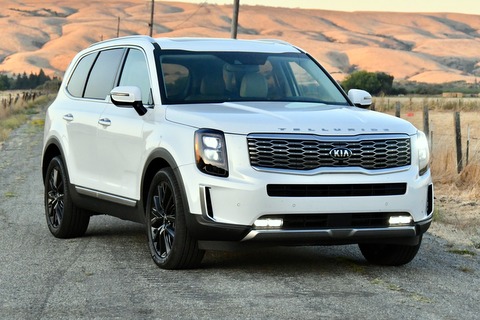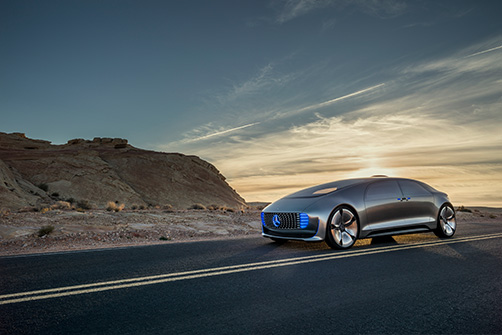Changes Are Already Happening, But More Are Coming
The future of automotive transportation is exciting.
The rapid advancement of autonomous vehicle technologies means tomorrow’s public roads will be vastly different from today’s. What’s more, the vehicles that will occupy public streets will radically alter automotive transportation as we know it.
When the topic of driverless cars is brought up, most conversations typically surround the benefits autonomous vehicles bring to traffic safety, productivity and transportation accessibility. But another important topic that needs to be discussed is fuel efficiency.
The Current State of Fuel Economy
While automotive manufacturers have made significant strides in improving average fuel efficiency over the years, this efficiency is dependent on numerous variables. Namely, consumer choices (fads, automaker promotions, etc.), the size of the vehicle and the deployment of fuel economy technologies in vehicles.

Bigger, heavier vehicles are driving down average fuel economy
In several major vehicle markets, growing consumer demand for larger vehicles has also been a significant determinant of average fuel economy. Demand for light-duty vehicles (LDVs) in markets like North America and Australia has contributed to the slowdown of average fuel economy improvements.
In emerging markets, economic development and rising incomes have resulted in robust vehicle sales growth. In regions such as the ASEAN region, transport represents a fast-growing energy sector. However, passenger vehicles in these regions are typically less fuel-efficient.
And with fuel consumption in these regions steadily rising, there is a need to significantly improve fuel efficiency in these emerging markets.
Recent Fuel Economy Advancements
Despite the growing demand for light-duty vehicles, the average fuel economy of new vehicles has significantly improved. Vehicles today are capable of getting more miles per gallon. Indeed, based on recent studies, on-road vehicle fuel economy is projected to increase by over 40% between 2015 and 2025.
This improvement in fuel efficiency can be attributed to a combination of technologies that include advancements in transmission engineering, improved vehicle aerodynamics, lightweight materials, and vehicle electrification.

Improvements in vehicle electrification have been one of the greatest fuel economy innovations in recent years. Their widespread implementation in new vehicles has enabled a greater range of offerings for consumers looking to purchase a fuel-efficient vehicle.
The affordability of electrical components and continued development of fuel cells have also given rise to a new vehicle market, the hybrid vehicle. But while hybrid vehicles have higher fuel efficiency than conventional vehicles, they are still subject to human error.
To further enhance the fuel efficiency of vehicles, another technological revolution has to occur.
The Rise of Autonomous Vehicles
The next wave in transportation innovation, autonomous vehicle technologies are set to transform the automotive industry in years to come. Early-stage automated vehicles are already present on public roads, but with limited automation.
This includes passenger cars capable of autonomous operations such as automated emergency braking, self-parking and lane-keeping assistance. While these highly-automated vehicles improve vehicle efficiency, they still require driving input from a human driver.

Fully automated and self-driving vehicles are capable of performing dynamic driving tasks without requiring human attention. While still in the development and testing phase, the capacity of autonomous vehicle technologies continues to rapidly evolve.
Car manufacturers—from Tesla to BMW—are already promising fully driverless cars to be commercially viable by 2021. Once self-driving cars proliferate public roads, various changes will occur.
Self-Driving Cars and Their Impact on Energy Consumption
There is no doubt that automated vehicles will forever transform travel patterns. Being able to engage in social, entertainment and work activities during travel times will allow users of driverless cars to travel longer distances.
The shape of urban cities, lifestyles and economic structures will change based on market penetration. Recent literature already highlights the associated benefits of self-driving cars.
These predictions include:
- Reduced congestion
- Increased platooning
- Improved crash avoidance
- Improved vehicle performance
- Increased highway and road speeds
- Travel cost reductions
- Eco-driving
- New mobility services
But while reduced congestion, eco-driving and improved vehicle performance indicate a reduction in fuel consumption, debate on this continues. Self-driving cars require additional self-driving and sensor equipment to enable fully autonomous capabilities.
Sensor equipment like cameras, laser-based imaging (lidar), radio-based imaging (radar), dedicated short-range communications (DSRC), inertial navigation systems (INS) all increase weight of the vehicle. Additional weight on a vehicle can result in decreases in fuel efficiency.

Further, hardware innovation like lidar must be mounted on top of the vehicle to offer the best field of vision. Early iterations of this technology will be large, being detrimental to the aerodynamics of a vehicle. This network of sensors will also require additional electrical power, reducing overall driving efficiency.
The smoother driving experience will also dramatically change user travel behavior. In the age of automated transport, passengers are not burdened with the driving role.This will encourage long-distance travel, which can increase the rate of energy consumption.
However, as autonomous mobility networks mature, so too with its hardware and software. Like any other computer system, hardware capabilities will advance. The network of sensors self-driving cars require will become smaller and faster, reducing excess weight in next-gen vehicle models.
On-board computing will also become more efficient as technology improves. This will be a vast change from the current prototypes. Battery technology will also improve, addressing the energy requirements of on-board sensors, transmitters and computers.
A more sophisticated communication network will enable vehicles to travel in greater synchronization and closer spacing. Known as platooning, this smoother driving cycle will reduce drag, thereby improving fuel efficiency and emissions.
And with self-driving cars able to better adjust to traffic conditions downstream and better obey speed advisory systems, vehicle performance can be optimized, minimizing excessive energy use.
Increased adoption rates of fully-autonomous vehicles by consumers will also inspire better energy savings. Greater use of autonomous vehicles will change driving patterns and will give rise to new mobility services such as robotaxis and ridesharing services.
These new business models will increase vehicle efficiency and usage, becoming an important fuel-saving measure in decades to come.
Driving Towards an Autonomous Future
As automotive vehicles change and become more autonomous by the middle of the next decade, certain industries will be impacted. Oil and gas in the autonomous mobility ecosystem will eventually be phased out.
This future autonomous state, though, will not completely displace conventional vehicles any time soon.

Barriers to entry will persist in the early days of self-driving cars. The cost of private driverless cars will be significant. Urban cities will also need to transform the existing infrastructure to support a network of autonomous vehicles on public roads.
And of course, consumer preferences can drastically alter different assumptions about the speed of adoption.
Even if conventional technologies persist, technological innovations have already contributed to improvements in fuel efficiency. As mentioned, real-world fuel efficiency is projected to rise significantly by 2025.
In time, the use of oil and gas in the transportation industry will be phased out. But that future state lies in a world where driverless cars are the norm. Until then, expect automakers to continue driving improvements in fuel efficiency.

1 thought on “Analysis: The Impact of Self-Driving Cars on Fuel Consumption”